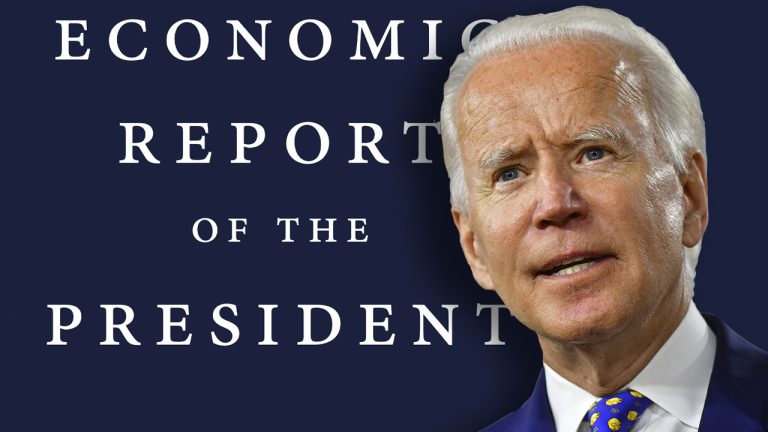 Regulations governing tokenized deposits and crypto assets are likely to become effective on Jan. 1, 2025, a senior fintech analyst at the South African central bank has revealed. However, according to the analyst, regulators are still trying to understand or learn the risks that come with using distributed ledger technology. Central Bank Considers Appropriateness of […]
Regulations governing tokenized deposits and crypto assets are likely to become effective on Jan. 1, 2025, a senior fintech analyst at the South African central bank has revealed. However, according to the analyst, regulators are still trying to understand or learn the risks that come with using distributed ledger technology. Central Bank Considers Appropriateness of […] On Monday, U.S. president Joe Biden published the administration’s economic report and addressed the subject of cryptocurrencies. The section titled “The Perceived Appeal of Crypto Assets” describes the currencies as “mostly speculative investment vehicles” that are “unbacked” and “traded without fundamental anchors.” The White House insists that crypto assets do not deliver on their promises […]
On Monday, U.S. president Joe Biden published the administration’s economic report and addressed the subject of cryptocurrencies. The section titled “The Perceived Appeal of Crypto Assets” describes the currencies as “mostly speculative investment vehicles” that are “unbacked” and “traded without fundamental anchors.” The White House insists that crypto assets do not deliver on their promises […]
The DLT Science Foundation opened its call for grant proposals, offering up to $5 million for eligible individuals or organizations.
The nonprofit DLT Science Foundation (DSF) has launched intending to foster the adoption of distributed ledger technology (DLT).
In an announcement sent to Cointelegraph, the DSF highlighted that it would offer support in several areas, including education, innovation and research. This means it will create educational material, workshops and open innovation programs, as well as grants and fellowships for academics.
The organization will also be providing support through grants to members of its university network. The network includes universities like the Indian Institute of Technology Madras, the London School of Economics, the National University of Singapore, University College London and the University of Zurich.
The DSF is also supported by the open-source public ledger project Hedera. According to the announcement, Hedera will lend its expertise in DLT to the DSF University Network.
The organization also opened its first call for grant proposals. According to the announcement, the DSF offers up to $5 million for eligible organizations or individuals.
Related: Bank of Italy selectively encouraging DLT, preparing for MiCA, governor says
Paolo Tasca, chairman and co-founder of the DSF, expressed his excitement over the potential breakthroughs that may come from its efforts. According to Tasca, unlocking the potential of DLT will lead to a better future for everyone. He explained that:
“The DLT Science Foundation aims to drive innovation, foster new collaborative models between academia, industry, and government, and promote the responsible adoption of DLT in business and society.”
Nikhil Vadgama, the director and co-founder of the organization, also commented on the launch. According to Vadgama, the DSF has an opportunity to empower academics and education in various universities. “Drawing from our own experiences and the challenges we have faced, we have developed grant programs that are specifically designed to address the needs of the DLT community,” Vadgama explained.

The proposed distributed ledger technology-backed “Asian yuan” token would supposedly help reduce Asia’s dependence on the U.S. dollar for international business.
Researchers from a Chinese state-run think tank have floated the idea of an Asia-wide digital currency with the aim to reduce its reliance on a United States dollar-based economy.
The views of researchers Liu Dongmin, Song Shuang, and Zhou Xuezhi from a unit of the Chinese Academy of Social Sciences (CASS) were published in an issue of the “World Affairs journal” posted online in late September, who said the establishment of an “Asian yuan” token would lower Asia’s reliance on the U.S. dollar.
Much like similar existing and trialed Central Bank Digital Currencies (CBDCs), the researchers said distributed ledger technology (DLT) would form the backing of the Asian token which would be pegged to a bundle of 13 currencies.
The currencies would include those of all 10 of the member nations in the Association of Southeast Asian Nations (ASEAN) along with China’s Yuan, Japan’s Yen, and South Korea’s Won according to the researchers.
“More than 20 years of deepened economic integration in East Asia has laid a good foundation for regional currency cooperation. The conditions for setting up the Asian yuan have gradually formed,” the researchers wrote in the journal seen by the South China Morning Post.
The journal is affiliated with China’s Foreign Affairs department with the researchers hailing from the “Institute of World Economics and Politics” one of many research units under CASS, a think tank with various ties to the country's ruling party.
The U.S dollar, and more recently cryptocurrencies have become a popular method for those in South East Asia to conduct business, send remittances, and hedge against the inflation of their respective local currencies.
Related: China accounts for 84% of all blockchain patent applications, but there's a catch
The research came a few weeks before a milestone in China’s CBDC pilot, the Bank of China on Oct. 10 said its e-CNY had transacted over 100 billion yuan, around $14 billion in value, with around 5.6 million merchant stores already supporting the digital yuan.
The country’s central bank is also partaking in Project Inthanon-LionRock, a DLT-backed cross-border payment CBDC trial also involving the Thai, Hong Kong, and United Arab Emirates central banks.
In September the trial saw the “successful” transaction of over $22 million worth of value in a month on its “Multiple CBDC Bridge” platform overseen by the Bank for International Settlements (BIS).

Over $12 million in value was issued in the pilot with commercial and central banks in Hong Kong, Thailand, the UAE and China taking part.
A multi-jurisdictional Central Bank Digital Currency (CBDC) pilot has been marked “successful” by the Bank for International Settlements (BIS) after a month-long test phase that facilitated $22 million worth of real-value cross-border transactions.
The central banks of Hong Kong, Thailand, China and the United Arab Emirates (UAE) took part in the pilot program along with 20 commercial banks from those regions.
More than $12 million worth of value was issued onto the test platform, which facilitated 164 foreign exchange transactions and cross-border payments between the participating firms totaling over $22 million worth of value according to a Tuesday LinkedIn post from the BIS.

Daniel Eidan an advisor and solution architect at the BIS said the pilot focused on wholesale CBDC cross-border payments and the role the central banks have on the platform, adding “we will likely consider more commercial aspects in the future stages of our work.”
The platform, known as “mBridge” short for Multiple CBDC (mCBDC) Bridge is a part of Project Inthanon-LionRock, a distributed ledger technology (DLT) CBDC cross-border payment project launched initially in Sept. 2019 involving the Thai and Hong Kong central banks.
With the first pilot of the platform now completed the project has moved into its third and final stage before a minimum version of the product with only the platform's core functionality is put to market.
A fully-functional CBDC cross payments platform will only be ready after revisions are made taking into account the feedback from the minimum version, according to a Sept. 2021 BIS report.
Related: Russia aims to use CBDC for international settlements with China: Report
The BIS added that a detailed progress report on mBridge will be released in October which will discuss technical design, legal, policy and regulatory considerations along with a future roadmap of mBridge.
A June report by the BIS revealed around 90% of central banks are investigating the adoption of CBDCs. Currently, 11 CBDCs have launched, 15 are in a pilot stage and 26 are in development according to the CBDC tracker from think tank Atlantic Council.

The South African Reserve Bank stated further work would be undertaken to study the findings from the project and used to inform policy and regulatory responses to DLT and CBDCs.
South Africa has taken another step closer to implementing its central bank digital currency (CBDC) as the South African Reserve Bank (SARB) concludes a technical proof-of-concept for the project.
The project, titled Project Khokha 2 (PK2), is the second phase of SARB’s Project Khokha (PK1), launched in 2018. It experimented with distributed ledger technology (DLT) for interbank payments' settlement, successfully replicating the banks’ “SAMOS” real-time gross settlement system.
This second phase, PK2 was launched in February 2021 and tested DLT with clearing, trading and settlement within the proof-of-concept environment with industry participants Absa, FirstRand, JSE Limited, Nedbank and Standard Bank who form the Intergovernmental Fintech Working Group (IFWG).
Using the technology, SARB tested the issuance of debt instruments and enabled two payment options for settlement, a wholesale central bank digital currency (wCBDC) and a wholesale settlement token (wToken), a commercial bank issued form of private money.
The proof-of-concept developed two DLT platforms, one which served as a decentralized trading platform and the other which managed the CBDC.
A bidirectional bridge similar to those used in DeFi when sending cryptocurrencies across different blockchains was also built, allowing portability of the CBDC between the two platforms.
The results of the project highlighted the regulatory, business, and operational implications that DLT would have in the market. A statement by SARB summarized that the technology would streamline functions carried out by separate infrastructures onto a single platform, potentially reducing cost and complexity.
Related: Sweden’s central bank completes second phase of e-krona testing
In the report, SARB does point out that the new DLT platforms will need to be integrated with legacy systems, with the costs of implementing the new platform placed on the banks.
New standards, updated best practices and new support systems would need to be established for the DLT infrastructure, according to SARB. The reserve bank mentioned that legacy and DLT systems might always have to run side-by-side, stating:
“A transition to a DLT-based system requires careful planning and execution and may involve running a DLT-based system in parallel to the existing system for a while, perhaps indefinitely.”
Technical risks related to the reliability and security of the software bridge between platforms were also noted, and the use of the CBDC on networks outside of the two used in the proof-of-concept was also flagged as topics for further consideration.
SARB says further work will be undertaken to study the findings from this phase of the project and the legal status of the wCBDC, which will be used to inform policy and regulatory responses to DLT and CBDCs in the financial markets.
It also hinted that another phase of Project Khokha may be started to “build on the work of PK2, performing live transactions in a sandbox environment in a different use case”.
Since May 2021, South Africa has also been engaged in a preliminary study on a retail CBDC focused on its “desirability and appropriateness” no exact date is set for the conclusion of the study, but SARB says it will be sometime in 2022.
 On Tuesday, Digital Currency Group’s (DCG) mining subsidiary, Foundry Digital, announced the company has joined the Texas Blockchain Council (TBC), a nonprofit industry association in the state of Texas. Foundry detailed the newly formed alliance is aimed at Foundry’s efforts to “help shape the regulatory landscape for digital assets” in North America. Foundry Becomes a […]
On Tuesday, Digital Currency Group’s (DCG) mining subsidiary, Foundry Digital, announced the company has joined the Texas Blockchain Council (TBC), a nonprofit industry association in the state of Texas. Foundry detailed the newly formed alliance is aimed at Foundry’s efforts to “help shape the regulatory landscape for digital assets” in North America. Foundry Becomes a […]
The researchers published results from “Project Hamilton,” which was first announced in 2020 to explore the use of existing and new tech to build and test a hypothetical CBDC platform.
Theoretical research into a Central Bank Digital Currency (CBDC) in the U.S. has found that distributed ledger architecture has “downsides.”
The Federal Reserve Bank of Boston and the Digital Currency Initiative at the Massachusetts Institute of Technology published their findings of their initial research into a CBDC on Feb 3.
The research project, dubbed “Project Hamilton,” tested a “hypothetical general purpose CBDC” using two potential models.
The first one processed transactions through “ordering server” distributed ledger technology (DLT), which organized the validated transactions into blocks to create an ordered transaction history.
The researchers were able to use this architecture to complete over 99% of transactions in under two seconds and the majority of transactions in under 0.7 seconds.
However, the ordering server resulted in a number of issues due to being run under the control of a single actor, the researchers concluding that “a distributed ledger architecture has downsides. “
“For example, it creates performance bottlenecks, and requires the central transaction processor to maintain transaction history, which one of our designs does not, resulting in significantly improved transaction throughput scalability properties."
They added that despite using ideas from blockchain technology, a “distributed ledger operating under the jurisdiction of different actors was not needed.”
The second architecture processed transactions in parallel on multiple computers, rather than relying on a single ordering server to prevent double spends. The researchers wrote that although “this results in superior scalability,” it did not “materialize an ordered history for all transactions.”
It demonstrated throughput of 1.7 million transactions per second with 99% of transactions durably completing in under a second, and the majority of transactions completing in under half a second.
Related: Fed issues discussion paper on benefits and risks of a digital dollar
Project Hamilton was first announced in 2020 to explore the use of existing and new technologies to build and test a hypothetical digital currency platform. The code is the first contribution to OpenCBDC, a project maintained by MIT which will serve as a platform for further CBDC research.
Boston Fed Executive Vice President and Interim Chief Operating Officer Jim Cunha said that the project illustrates that it is “critical” for change makers to not only understand how emerging technologies could support a potential CBDC, but also what challenges remain.
“This collaboration between MIT and our technologists has created a scalable CBDC research model that allows us to learn more about these technologies and the choices that should be considered when designing a CBDC."
The director of the Digital Currency Initiative at MIT Neha Narula said that "there are still many remaining challenges in determining whether or how to adopt a central bank payment system for the United States.”
 ESMA, the European Securities and Markets Authority, has set out to establish if EU authorities need to amend existing regulations in order to facilitate the trading and settlement of tokenized securities. The regulator is now seeking opinions on the matter ahead of launching a pilot regime for market infrastructures based on distributed ledger technology (DLT). […]
ESMA, the European Securities and Markets Authority, has set out to establish if EU authorities need to amend existing regulations in order to facilitate the trading and settlement of tokenized securities. The regulator is now seeking opinions on the matter ahead of launching a pilot regime for market infrastructures based on distributed ledger technology (DLT). […]